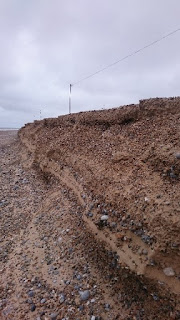In the run up to June and with
all this warm sun, the flowering plants are beginning to carpet the dunes in colour.
With many early plants like the Common Stork's-bill Erodium cicutarium, which has been flowering since April, already
coming into seed, we are seeing new plants emerging every day. If you have been
out walking the shingle ridge this month you would have seen the monstrous Sea Kale Crambe maritima in full bloom
and the first of the Yellow Horned-poppy’s Glaucium
flavum, which have thrown out their vibrant yellow flowers from prickly
blue-green capsules. On the Point, the Common Cat’s-ear Hypochoeris radicata and Mouse-ear Hawkweed Pilosella officinarum are laying down a carpet of yellow over the
dunes and Thrift Armeria maritima has
been covering vast stretches of Great Sandy low in a cloud of pink. If you are
on the Point next month you will see the Sea-lavender begin to flower, but with
four species; Common, Rock, Matted and Lax-flowered on the Point, you will have
to look a little closer to tell them apart.
Sea Kale (Wynona Legg)
Yellow Horned-poppy (Wynona Legg)
With the emerging flowers comes bustling insects ready to
take full advantage of their sweet nectar and rich pollen. We are seeing good
numbers of common blue butterflies along the shingle ridge and small copper
flitting among the sheep sorrel in the dune among other travellers coming in
off the sea. An abundance of caterpillars can be seen at this time including
the moth of the Garden Tiger Arctia caja,
sometimes known as ‘the woolly bear’ due to its dense long hairs...
We have our first tern nests of
the year confirmed this week. With 29 Common Tern and 7 Little Tern nests it is
a good start to the year for them and in the next few weeks we hope to see the
numbers of pairs grow. With trail cams recording sections of the shingle beach,
we hope to get some footage of settling pairs next to their ceramic decoy
neighbours, which have been up since April.
Common Tern (Dan Wynn)
In seal news, we have had our first
healthy Common Seal pup, which was found on the Point today with mum keeping a
close watch.
Those recent strong winds and
turbulent tides have scoured out some of the shingle on a small section of the
upper beach, leaving a steep shelf. You can see the layers of deposited sand
and shingle which have formed the beach over time and the incredibly long roots
of some of the dune plants which have been exposed.
The long roots of Sea Sanwort (Wynona Legg)
Wynona,
Seasonal Assistant Ranger






















